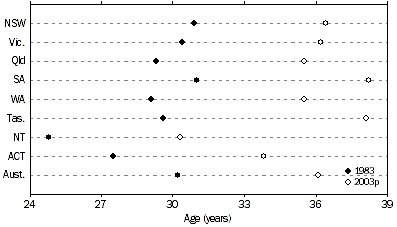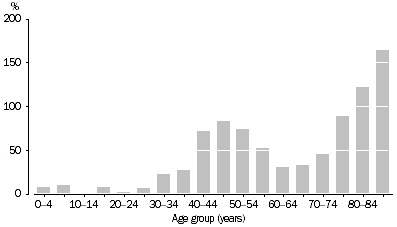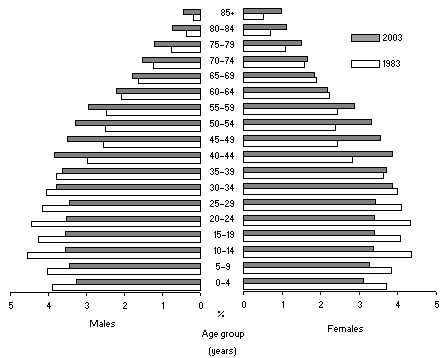POPULATION BY AGE AND SEX - AUSTRALIAN STATES AND TERRITORIES
The following selected findings have been taken from the ABS publication Population by Age and Sex, Australian States and Territories (cat. no. 3201.0) which was released on 19 December 2003.
Introduction
In the twelve months to 30 June 2003, the Australian population increased by 240,500 people reaching 19,881,500 in total. All states and the Australian Capital Territory increased in population during 2002–03. Only the Northern Territory had a decrease in population of 300 people and a growth rate of –0.2%. Queensland had the highest growth rate at 2.3% followed by Western Australia with 1.4%, both above the Australian rate of 1.2%. The lowest positive growth rate of 0.4% was recorded by the Australian Capital Territory, followed by South Australia (0.6%) and New South Wales (0.8%).
Ageing population
The median age of the Australian population, the age at which half the population is older and half is younger, has increased by 5.9 years in the last 20 years from 30.2 years at 30 June 1983 to 36.1 years at 30 June 2003. Between 30 June 2002 and 2003 there was an increase in the median age of 0.2 years. Australia's population is ageing because of a sustained low level of fertility, which has resulted in proportionally fewer children in the population, and increased life expectancy.
South Australia had the oldest population
As at 30 June 2003, the population of South Australia had the highest median age of all states and territories (38.2 years) followed by Tasmania (38.1 years), New South Wales (36.4 years), Victoria (36.2 years), Queensland and Western Australia (35.5 years), the Australian Capital Territory (33.8 years) and the Northern Territory (30.3 years).
MEDIAN AGE OF POPULATION

Age structure
Between 30 June 1983 and 30 June 2003, the proportion of children aged 0-14 years in the population has declined from 24% in 1983 to 20% in 2003. Over the same period, the proportion of the population aged 15-64 years increased marginally to 67% while the proportion of people aged 65 years and over increased by 3% to 13%.
POPULATION CHANGE, Age group - 1983 to 2003p

POPULATION, Age and Sex—1983 and 2003p

Children
There was a decrease of 4,800 children (0.1%) aged under 15 years in Australia in the 12 months to 30 June 2003. The increase in the number of children aged 10-14 years of 11,500 was offset by decreases of 10,000 children in the 5-9 year age group and 6,300 children in the 0-4 year age group.
Queensland was the only state to record an increase in the number of children aged 0–14 years (1.0%) in the twelve months to 30 June 2003. All other states and territories declined with Victoria declining by 0.2%, Western Australia by 0.3%, New South Wales and Tasmania by 0.4%, the Northern Territory by 0.6%, South Australia by 0.7% and the Australian Capital Territory by 1.6%.
Adults
The adult population (people aged 15 years and over) in Australia increased in the 12 months to 30 June 2003 by 245,300 people (1.6%). However, this growth was unevenly distributed across the age groups of the population. The growth rate for those aged 15-44 years (0.8%) was lower and for those aged 45 years and over (2.5%) was higher than the growth rate for the total adult population.
Aged 15-64 years
The number of people aged 15–64 years grew by 1.4% during the twelve months to 30 June 2003. For this age group the states to experience growth rates above the national average were Queensland (2.6%), Western Australia (1.7%) and Victoria (1.5%). The only state or territory to record a decrease of population in this age group was the Northern Territory (-0.3%). The remaining states and territories all experienced increases below the national average: Tasmania (1.1%), New South Wales (1.0%), South Australia (0.8%), and the Australian Capital Territory (0.6%).
Aged 65 years and over
In the 12 months to 30 June 2003, the number of people aged 65 years and over in Australia increased by 2.2% to just over 2.5 million. This age group comprised 12.8% of the population. Generally, the population growth in this age group was high for the states and territories which had a small proportion of their population in this age group. Whereas the opposite was true for states and territories which had a larger proportion of their population aged 65 years and over.
Aged 85 years and over
Proportionally, the greatest population increase in the year to 30 June 2003 occurred among people aged 85 years and over. During this period, the number of people in this age group increased from 276,900 to 289,500, a growth rate of 4.6%. This continued the rapid increase in the size of this age cohort, which has grown by 165% over the last twenty years, compared to a total population growth of 29% over the same period.
Increased life expectancy for both men and women has contributed to this rise. Reflecting the higher life expectancy of women compared to men, there were over twice as many females (198,100) than males (91,400) in this age group at 30 June 2003.
In the 12 months to 30 June 2003, the fastest increases in the number of people aged 85 years and over occurred in the Northern Territory (9.6%), the Australian Capital Territory (8.1%), Queensland (6.1%), South Australia (5.2%) and New South Wales (4.7%). Growth for these states and territories for people aged 85 years and over was higher than growth for this age group for Australia. The smallest percentage increase occurred in Western Australia (3.2%), followed by Victoria (3.6%) and Tasmania (4.3%).
International comparison
The trend toward population ageing is established in many countries. In countries such as Italy, Japan and Greece, the number of people aged 65 years and over already exceeds the number of children aged 0–14 years. Population ageing in these countries is a result of sustained low fertility rates, coupled with relatively high life expectancy. In Australia based on the Australian Bureau of Statistics Series B population projection, the number of people aged 65 years and over is projected to exceed the number of children aged 0–14 years around the year 2016. See Population Projections, Australia, 2002 to 2101 (cat. no. 3222.0) .
According to United Nations projections, all countries selected for analysis are expected to experience a decrease in the proportion of children in their populations between 2000 and 2005. In the majority of these countries, the decrease of children aged 0-14 years is expected to be accompanied by increases in the proportions of people aged 15–64 years and/or of people aged 65 years and over. Countries such as Italy, Japan and Greece are expected to suffer proportional declines in their populations aged 15-64 years as well as their populations aged 0-14 years. These countries are therefore expected to experience large proportional increases in their populations aged 65 years and over.
In 2000, the age structure of Australia's population was similar to that of Canada and the United States of America. Generally, the European countries and Japan had smaller proportions of children and higher proportions of older people than did Australia. In contrast, countries from the Asian region tended to have proportionally more children and far fewer older people, generally reflecting considerably higher fertility rates and lower life expectancies at birth than those experienced in Australia.
For further information about these and related statistics, contact the National Information Referral Service on 1300 135 070.
 Print Page
Print Page
 Print All
Print All